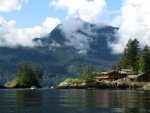Hi Colby,
If you send me your email address, I could send you our list of SE AK anchorages we've developed over 15 trips. With charts and the Douglass cruising guide, could keep you busy reading for a while. We've stayed in most, but not all, of these anchorages, and all the towns/marinas mentioned. Page numbers are from the Douglass Exploring series cruising guides.
When we started cruising the PNW we would study charts and cruising guides together, and write down anchorages we thought would be useful. With experience, we added brief comments on some, when we thought there was something worth remembering that was not necessarily in the cruising guide. Anchorages without comments may be ones we have not yet used, or ones where no additional comment seemed necessary.
They are listed roughly in the sequence you might come upon them as you travel. When we're deciding where to go next, we often look at the lists rather than hauling out the cruising guide. Makes it easy to select the day's destination, and to have in mind a few places along the way where we might bail out, if weather begins to be a problem.
PS: I'm still working on notes about various routes we've taken.
You mentioned Glacier Bay. If you haven't yet seen the section in my book about GB, here it is (pretty much still accurate, I think):
For many cruisers a visit to Glacier Bay is a lifetime goal. Sitting right in front of a tidewater glacier in your own little boat, watching 100-200 foot chunks of ice calving into the sea, is an experience never to be forgotten. And critter-watching is super.
Chart:
http://www.charts.noaa.gov/OnLineViewer/17318.shtml
Cruising Glacier Bay is no trivial undertaking. It is a very big place, and with its huge snow-covered mountains has some of the most challenging weather in Southeast. Distances are great, anchorages are few, and there are several restrictions.
Only 25 boats are allowed in Glacier Bay at a time, and you need an entry permit. Many cruisers make reservations ahead of time, and then find that weather or other difficulties make their schedule unworkable. From our experience, the best way to get a permit may be waiting to call Park HQ at Bartlett Cove until you’re close by (say at Hoonah or in Icy Strait), and the forecast for the next few days looks reasonable. For best odds, call right at 6 AM (they’re open 6 AM - 10:30 PM) on either (907) 697-2627 or VHF 12. Chances are fairly good that a cancellation has freed up a permit, and you can take advantage of it if you’re nearby and ready. If no permit is available, ask again later – they don’t mind.
You’ll need a minimum of two days in Glacier Bay to make it to and from the Margerie Glacier. The Margerie, at the top of Glacier Bay some 60 miles from the entrance, is a spectacular and active calving glacier. You can get fairly close to its face, some 200-300 feet high. On the way north, the Lamplugh and Johns Hopkins glaciers are spectacular as well. With a third or fourth day, you could see quite a bit more, at a less frantic pace, and have better odds of dealing with uncooperative weather.
To start your Glacier Bay excursion, stop in at Park HQ and attend an orientation on do’s and don’ts. As of 2008 the lecture was given only at pre-scheduled times, so you’ll want to plan your first day accordingly. You might try entering the park very early, calling Bartlett Cove to check in when you cross the boundary. Tie up at the float, and catch the 8AM orientation (bring your National Geographic map of the Bay so you can see details). With good weather, you should be able to make it a good part of the way north, to an anchorage at North Sandy Cove, Blue Mouse Cove, or in front of the glacier in Reid Inlet.
Parts of the bay are considered whale waters, where boat speed is limited to 13 knots. Even with a fast boat, you’ll find that first day pretty full, getting through the entry process and on to an anchorage, unless you anchor right there in Bartlett Cove (the float’s limited to a three-hour stay, except for dinghies). If you do anchor in Bartlett Cove, be aware that it’s open to the west, and can get pretty lumpy in a west wind. You could also anchor at Fingers Bay without traveling too far – but remember to enter very carefully.
From North Sandy, Blue Mouse, or Reid, you could head north the next morning, spend 2-4 hours at the Margerie Glacier, and come back south to anchor again. As you slowly approach the glacier through fields of bergy bits, keep a sharp lookout for small ones called “growlers”, only a foot or a few feet long, and often nearly clear. These weigh more than you might guess, and can give your boat or your prop quite a thump. The smaller ones make great ice for the cooler.
If you get back to Bartlett Cove for your last evening, and are out of permit days, the following morning you can call and obtain a “transit permit” to leave the park that day.
If the weather sounds intimidating, or you’re able to get only one or two permit days, a nice way to see Glacier Bay is the Fairweather Express tour boat, operated by the park lodge.
 Colby
Colby
